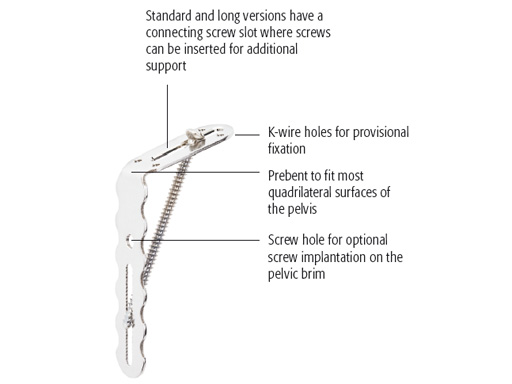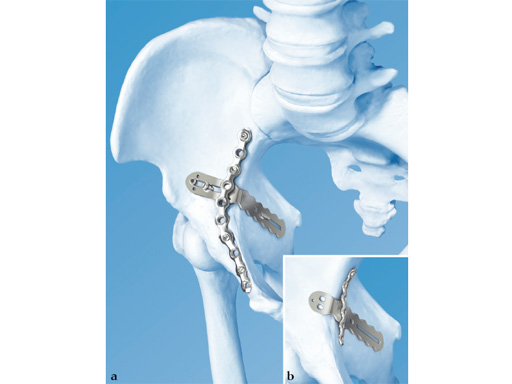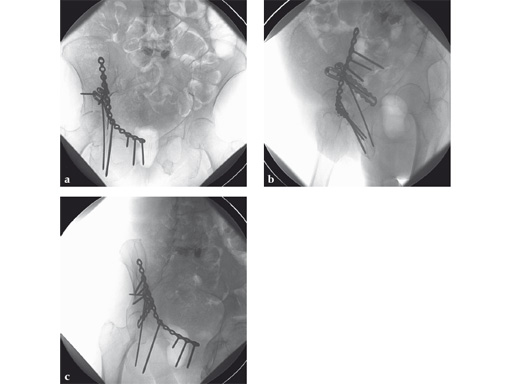
3.5 mm Quadrilateral Surface Plate
The increasing number of acetabular fractures in elderly, osteoporotic individuals has added new technical challenges to surgical management. A common group of fracture patterns in this population is the anterior wall or column often with an associated posterior hemitransverse. These injuries frequently also include quadrilateral surface comminution which can make both reduction and stabilization more difficult. The 3.5 mm quadrilateral surface plate was developed to provide a more effective way to deal with these issues, for example, a way to deal with the quadrilateral surface enbloc for reduction, allowing buttress stabilization, which is independent of bone density.
The new 3.5 mm quadrilateral surface plates are intended for use in acetabular fracture patterns amenable to an anterior surgical approach, which have an important component of quadrilateral surface comminution. They are typically used in conjunction with pelvic reconstruction plates. There are three plate sizes (short, standard, and long) available which are made of 316L stainless steel and are part of the 3.5 mm low-profile pelvic system. The standard and long plate versions have a connecting screw slot where triangulated buttress screws can be inserted for additional support (Fig 1). These interconnecting screws should be 2 mm longer than the actual length measured to ensure that the screw engages the serrated teeth of the plate at the quadrilateral surface. All plates are prebent to fit most quadrilateral surface anatomy, but minor contouring may still be necessary. Reconstruction plates are often placed on the pelvic brim or the endopelvic surface over the 3.5 mm quadrilateral surface plates to aid final plate fit and provide additional buttress function (Fig 2, Fig 3).
Case provided by Keith Mayo, Tacoma, USA: An elderly woman with steroid-dependent chronic obstructive pulmonary disease on home oxygen sustained an anterior column plus posterior hemitransverse acetabular fracture in a ground-level fall from her electric scooter.
Fig 1ad AP pelvis, Judet oblique, and coronal CT scan views of associated anterior column plus posterior hemitransverse acetabular fracture. This pattern is problematic for multiple reasons, including mild impaction of virtually the entire weight-bearing surface with additional separate impaction of the displaced anterior column, quadrilateral surface comminution, and severe osteoporosis.
Fig 2ab Intraoperative AP hip and iliac oblique image intensifier images of a portion of the reduction sequence utilizing distal/lateral traction through a Schanz screw, ball spike (picador) with disc and asymmetrical reduction clamp with disc. The remaining area of incompletely reduced articular surface was a free, thin osteochondral fragment retrieved through the anterior column fracture. It was reoriented and trapped between the lateral articular surface, displaced anterior column, and femoral head. Despite multiple attempts this position could not be further improved. Cancellous autologous bone graft was used to buttress this area through a small internal iliac fossa cortical window.
Fig 3ab AP hip and iliac oblique image intensifier views show initial quadrilateral surface plate placement with the aid of an asymmetrical clamp and subsequent introduction of overlying pelvic brim reconstruction plate. In this case a locking pelvic brim plate was chosen because of the severe osteoporosis.
Fig 4ac AP pelvis and Judet oblique x-rays 9 months postoperatively. The patient started full weight bearing at approximately 10 weeks postoperatively. The fractures healed without secondary displacement. The patient returned to preinjury (relatively limited) activity level with no significant residual pain complaints.
Note: In this case the quadrilateral surface plate has been useful both as an interim reduction aid and to augment prior stabilization constructs. In effect, it provides a "prosthetic" cortex for the quadrilateral surface as well as enhancing posterior column stability in a way not possible with typical anterior to posterior column lag or position screws alone.
Hazards and labeling
Due to varying countries’ legal and regulatory approval requirements, consult the appropriate local product labeling for approved intended use of the products described on this website. All devices on this website are approved by the AO Technical Commission. For logistical reasons, these devices may not be available in all countries worldwide at the date of publication.
Legal restrictions
This work was produced by AO Foundation, Switzerland. All rights reserved by AO Foundation. This publication, including all parts thereof, is legally protected by copyright.
Any use, exploitation or commercialization outside the narrow limits set forth by copyright legislation and the restrictions on use laid out below, without the publisher‘s consent, is illegal and liable to prosecution. This applies in particular to photostat reproduction, copying, scanning or duplication of any kind, translation, preparation of microfilms, electronic data processing, and storage such as making this publication available on Intranet or Internet.
Some of the products, names, instruments, treatments, logos, designs, etc referred to in this publication are also protected by patents, trademarks or by other intellectual property protection laws (eg, “AO” and the AO logo are subject to trademark applications/registrations) even though specific reference to this fact is not always made in the text. Therefore, the appearance of a name, instrument, etc without designation as proprietary is not to be construed as a representation by the publisher that it is in the public domain.
Restrictions on use: The rightful owner of an authorized copy of this work may use it for educational and research purposes only. Single images or illustrations may be copied for research or educational purposes only. The images or illustrations may not be altered in any way and need to carry the following statement of origin “Copyright by AO Foundation, Switzerland”.
Check www.aofoundation.org/disclaimer for more information.
If you have any comments or questions on the articles or the new devices, please do not hesitate to contact us.
“approved by AO Technical Commission” and “approved by AO”
The brands and labels “approved by AO Technical Commission” and “approved by AO”, particularly "AO" and the AO logo, are AO Foundation's intellectual property and subject to trademark applications and registrations, respectively. The use of these brands and labels is regulated by licensing agreements between AO Foundation and the producers of innovation products obliged to use such labels to declare the products as AO Technical Commission or AO Foundation approved solutions. Any unauthorized or inadequate use of these trademarks may be subject to legal action.
AO ITC Innovations Magazine
Find all issues of the AO ITC Innovations Magazine for download here.
Innovation Awards
Recognizing outstanding achievements in development and fostering excellence in surgical innovation.












